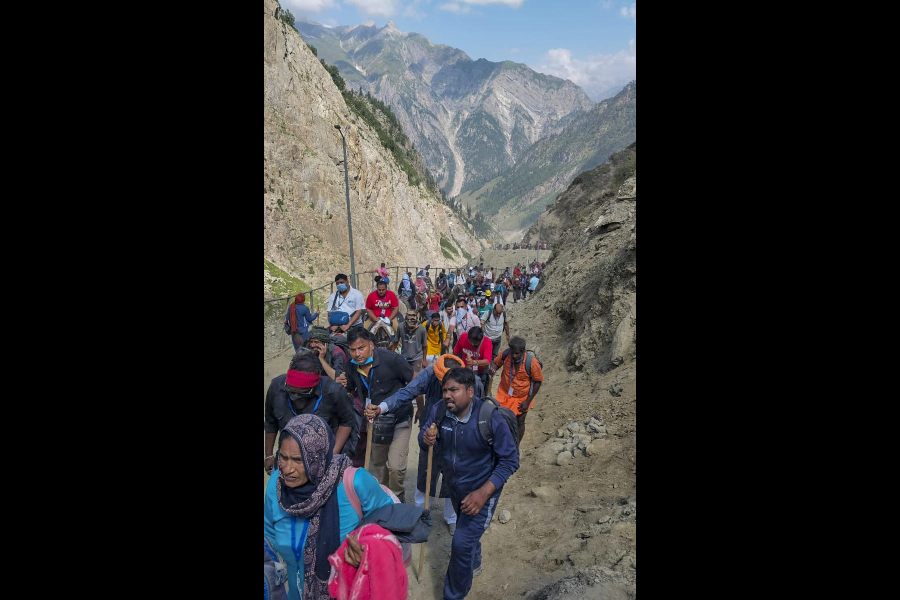 |
| Members of tribal orgnisations rally in Ranchi protesting against de-reservation of seats in panchayat elections. A Telegraph file picture |
This is the third part of the ruling delivered by a bench of Chief Justice Altamas Kabir and Justice S.J. Mukhopadhyay striking down as unconstitutional several provisions of the Panchayat (Extension to Scheduled Areas) Act, 1996, a central law, and the Jharkhand Panchayat Raj Act, 2001.
The state government enacted Jharkhand Panchayat Raj Act, 2001, as amended from time to time, also exercised power under clause G of article 243-D of the Constitution, reserving certain seats of panchayats in favour of other backward category.
Under Section 17, while reservation has been made in favour of Scheduled Castes and Scheduled Tribes for the seats of gram panchayats, proportionate reservation has been made in favour of Scheduled Castes and Scheduled Tribes, both for scheduled and non-scheduled areas, proportionate to the population of Scheduled Castes and Scheduled Tribes.
In panchayats, while a minimum 50 per cent of seats has been reserved for Scheduled Tribes in the scheduled areas, reservation in favour of other backward classes, proportionate to their population in the panchayats, has also been allowed in the scheduled areas, with a limit of maximum 80 per cent.
In non-scheduled areas, reservation in favour of Scheduled Castes and Scheduled Tribes, if jointly found to be less than 50 per cent, the remaining seats have been reserved for backward category, proportionate to their population in the panchayats, but with a limit of 50 per cent reservation. Similar reservation has been made at other levels, such as panchayat samiti level under Section 36 and zila parishad level under Section 51.
So far as the seats and offices of the chairpersons are concerned, provisions for reservation have been made under Sections 21, 40 and 55 of the Jharkhand Panchayat Raj Act, 2001.
Curiously enough, the seats and offices of chairpersons in the non-scheduled areas have not been reserved on the ground that the seat of a chairperson is a solitary seat. This will be evident from Sections 21(A), 40(A) and 55(A) of Jharkhand Panchayat Raj Act, 2001.
On the other hand, such seats and offices of chairpersons of scheduled areas have not been treated as solitary seats and cent per cent reservation of the seats and offices of all chairpersons at all levels have been made, as is evident from Sections 21(B), 40(B) and 55(B) of the Act.
From Section 22(D) of the Jharkhand Panchayat Raj Act, 2001, it appears that office of up-mukhiya (one of the chairpersons) has been treated to be solitary seat and it has also been kept unreserved for both scheduled and non-scheduled areas, though it is shown to be reserved for scheduled areas under Section 21(B) of the Jharkhand Panchayat Raj Act, 2001.
Scheduled Areas: History of scheduled areas can be traced out from British India period. Scheduled Districts Act, 1874 (Act XIV of 1874) was enacted declaring Santhal Parganas and Chutia Nagpur Division (now known as Chhotanagpur division), both now fall within the territory of Jharkhand as ?scheduled districts?.
Generally tribal communities themselves regulate their politico-socio-legal affairs on the basis of principles, procedures, practices, norms, conventions, traditions, precedents and so on. They choose their leader (tribal chief) based on informal consensus or selection by the people of the village. Decision-making also has been through consensus.
The traditional practices, process and procedures of tribal communities are different from others, i.e. non-tribal. In the state of Jharkhand, in different scheduled areas, a gram sabha is continuing since long, which represent such an entity at village or hamlet level. Over and above it, a group of villages or hamlets are existing, which are called as parganas or anchal or parha. The tribal communities are managing their affairs all through the ages. Provision for administration of scheduled areas and scheduled tribes are contained in Article 244(1) and Fifth schedule of the Constitution.
The major features of the Fifth Schedule, in the present context, are the governor?s power to adopt laws, passed by Parliament and the state legislature, and making regulations for the scheduled areas, having the force of law, and extension of executive power of the Union government to give direction to the state for administration of scheduled areas. The governor, by notification, may also direct that any particular Act by Parliament or an legislature of the state shall not apply to a scheduled area or any part thereof in the state or shall apply to a scheduled area or any part thereof in the state, subject to such exceptions and modifications, as he may specify in the notification.
In exercise of powers, conferred by sub-paragraph (I) of Paragraph 6 of the Fifth Schedule to the Constitution of India, the President of India made an order in 1950 known as ?The Scheduled Area Part A states Order, 1950. In the then combined state of Bihar, Ranchi district, Singhbhum district, excluding Dhalbhum subdivision, Santhal Parganas district, excluding Godda and Deoghar subdivisions and Latehar sub-division of Palamau district were declared to be the scheduled areas vide notification, published on 26th January, 1950. All the aforesaid districts and sub-divisions now fall within the territory of Jharkhand.
In exercise of power, conferred by sub-paragraph (ii) of Paragraph 6 of the Fifth Schedule, the President rescinded ?The Scheduled Area (Part A States) Order, 1950?, so far it relates to the then combined state of Bihar and some other states, was pleased to make an order, known as ?The scheduled areas (states of Bihar, Gujarat, Madhya Pradesh and Orissa), Order, 1977.
By the said order, Ranchi district, Singhbhum district, Latehar subdivision and Bhandara block of Garhwa subdivision in Palamu district, Dumka, Pakur, Rajmahal and Jamtara subdivisions and Sundarpahari and Boanjor blocks of Godda subdivisions in Santhal Pargana district were shown as scheduled areas of the then combined state of Bihar, all of which now fall within the territory of Jharkhand.










